Marketing Portfolio: TESCO and ALDI Strategies Analysis Report
VerifiedAdded on 2021/01/01
|10
|3144
|195
Report
AI Summary
This report provides a comparative analysis of the marketing strategies employed by TESCO and ALDI, two prominent players in the UK retail sector. The report begins with an introduction to marketing strategy, emphasizing its role in achieving organizational objectives and gaining a competitive edge. It then delves into the specifics of TESCO and ALDI, including their company profiles, market positioning, and competitive landscapes. The core of the report examines the marketing strategies of both companies, focusing on the 4Ps (Product, Price, Promotion, and Place). The report highlights TESCO's focus on online sales, product diversification, and its 'Every Little Helps' slogan, as well as ALDI's emphasis on private labels, low prices, and promotional strategies. The report concludes with recommendations for TESCO to improve its promotional strategy, particularly through increased use of social media. The report uses the SMART objective framework to measure the success of the recommendations. Overall, the report offers valuable insights into the marketing practices of these two major retailers and their approaches to customer acquisition and retention.

Individual Marketing Portfolio
Paraphrase This Document
Need a fresh take? Get an instant paraphrase of this document with our AI Paraphraser
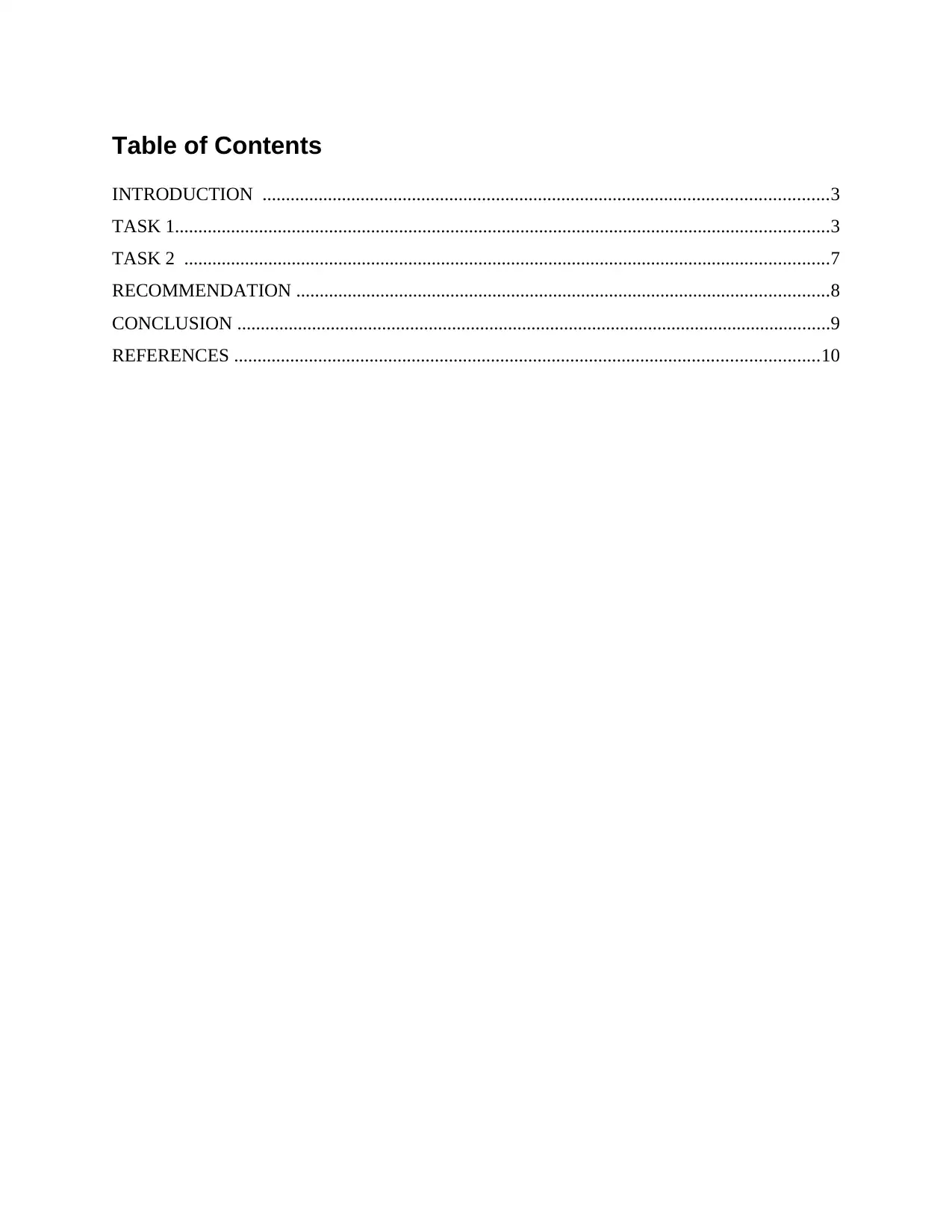
Table of Contents
INTRODUCTION .........................................................................................................................3
TASK 1............................................................................................................................................3
TASK 2 ..........................................................................................................................................7
RECOMMENDATION ..................................................................................................................8
CONCLUSION ...............................................................................................................................9
REFERENCES .............................................................................................................................10
INTRODUCTION .........................................................................................................................3
TASK 1............................................................................................................................................3
TASK 2 ..........................................................................................................................................7
RECOMMENDATION ..................................................................................................................8
CONCLUSION ...............................................................................................................................9
REFERENCES .............................................................................................................................10
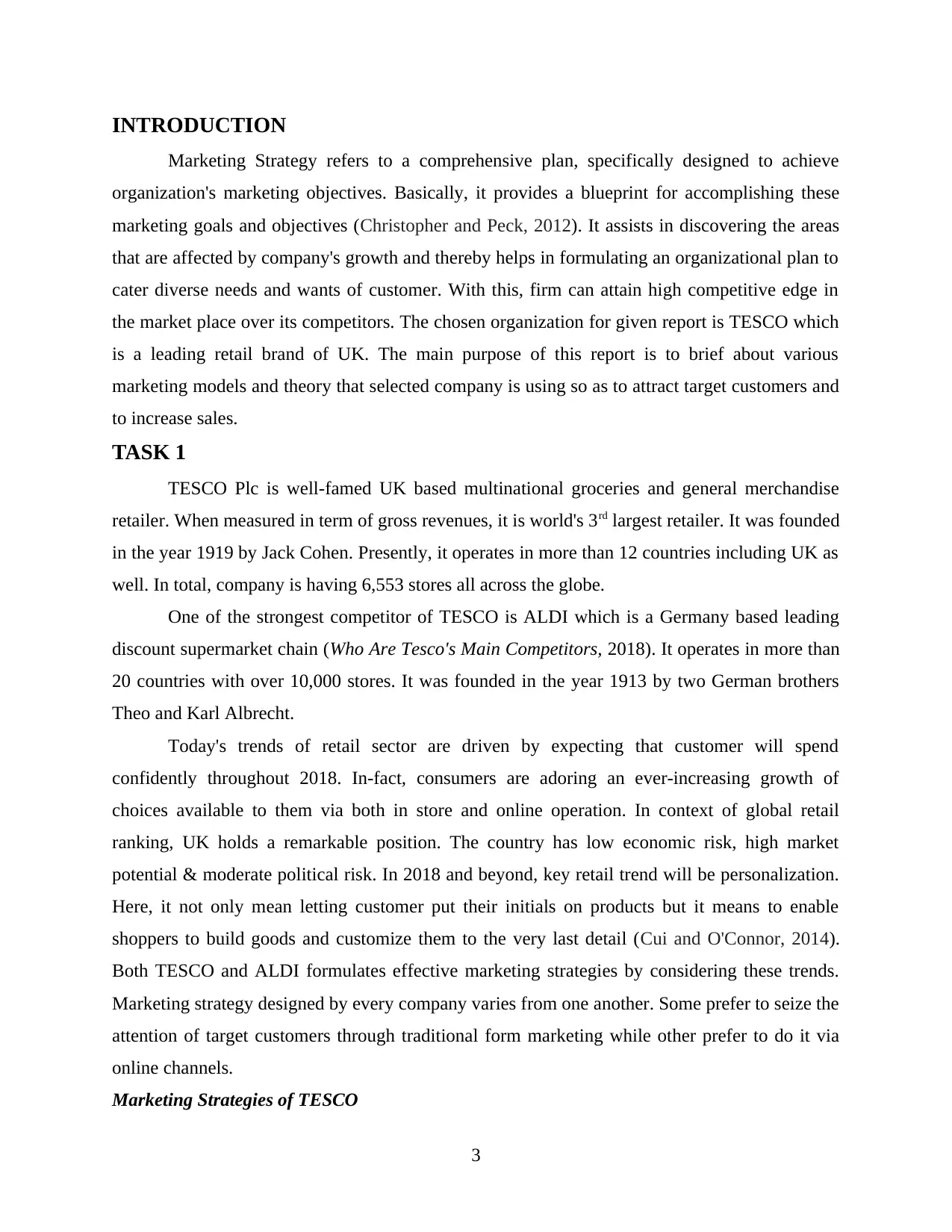
INTRODUCTION
Marketing Strategy refers to a comprehensive plan, specifically designed to achieve
organization's marketing objectives. Basically, it provides a blueprint for accomplishing these
marketing goals and objectives (Christopher and Peck, 2012). It assists in discovering the areas
that are affected by company's growth and thereby helps in formulating an organizational plan to
cater diverse needs and wants of customer. With this, firm can attain high competitive edge in
the market place over its competitors. The chosen organization for given report is TESCO which
is a leading retail brand of UK. The main purpose of this report is to brief about various
marketing models and theory that selected company is using so as to attract target customers and
to increase sales.
TASK 1
TESCO Plc is well-famed UK based multinational groceries and general merchandise
retailer. When measured in term of gross revenues, it is world's 3rd largest retailer. It was founded
in the year 1919 by Jack Cohen. Presently, it operates in more than 12 countries including UK as
well. In total, company is having 6,553 stores all across the globe.
One of the strongest competitor of TESCO is ALDI which is a Germany based leading
discount supermarket chain (Who Are Tesco's Main Competitors, 2018). It operates in more than
20 countries with over 10,000 stores. It was founded in the year 1913 by two German brothers
Theo and Karl Albrecht.
Today's trends of retail sector are driven by expecting that customer will spend
confidently throughout 2018. In-fact, consumers are adoring an ever-increasing growth of
choices available to them via both in store and online operation. In context of global retail
ranking, UK holds a remarkable position. The country has low economic risk, high market
potential & moderate political risk. In 2018 and beyond, key retail trend will be personalization.
Here, it not only mean letting customer put their initials on products but it means to enable
shoppers to build goods and customize them to the very last detail (Cui and O'Connor, 2014).
Both TESCO and ALDI formulates effective marketing strategies by considering these trends.
Marketing strategy designed by every company varies from one another. Some prefer to seize the
attention of target customers through traditional form marketing while other prefer to do it via
online channels.
Marketing Strategies of TESCO
3
Marketing Strategy refers to a comprehensive plan, specifically designed to achieve
organization's marketing objectives. Basically, it provides a blueprint for accomplishing these
marketing goals and objectives (Christopher and Peck, 2012). It assists in discovering the areas
that are affected by company's growth and thereby helps in formulating an organizational plan to
cater diverse needs and wants of customer. With this, firm can attain high competitive edge in
the market place over its competitors. The chosen organization for given report is TESCO which
is a leading retail brand of UK. The main purpose of this report is to brief about various
marketing models and theory that selected company is using so as to attract target customers and
to increase sales.
TASK 1
TESCO Plc is well-famed UK based multinational groceries and general merchandise
retailer. When measured in term of gross revenues, it is world's 3rd largest retailer. It was founded
in the year 1919 by Jack Cohen. Presently, it operates in more than 12 countries including UK as
well. In total, company is having 6,553 stores all across the globe.
One of the strongest competitor of TESCO is ALDI which is a Germany based leading
discount supermarket chain (Who Are Tesco's Main Competitors, 2018). It operates in more than
20 countries with over 10,000 stores. It was founded in the year 1913 by two German brothers
Theo and Karl Albrecht.
Today's trends of retail sector are driven by expecting that customer will spend
confidently throughout 2018. In-fact, consumers are adoring an ever-increasing growth of
choices available to them via both in store and online operation. In context of global retail
ranking, UK holds a remarkable position. The country has low economic risk, high market
potential & moderate political risk. In 2018 and beyond, key retail trend will be personalization.
Here, it not only mean letting customer put their initials on products but it means to enable
shoppers to build goods and customize them to the very last detail (Cui and O'Connor, 2014).
Both TESCO and ALDI formulates effective marketing strategies by considering these trends.
Marketing strategy designed by every company varies from one another. Some prefer to seize the
attention of target customers through traditional form marketing while other prefer to do it via
online channels.
Marketing Strategies of TESCO
3
⊘ This is a preview!⊘
Do you want full access?
Subscribe today to unlock all pages.

Trusted by 1+ million students worldwide
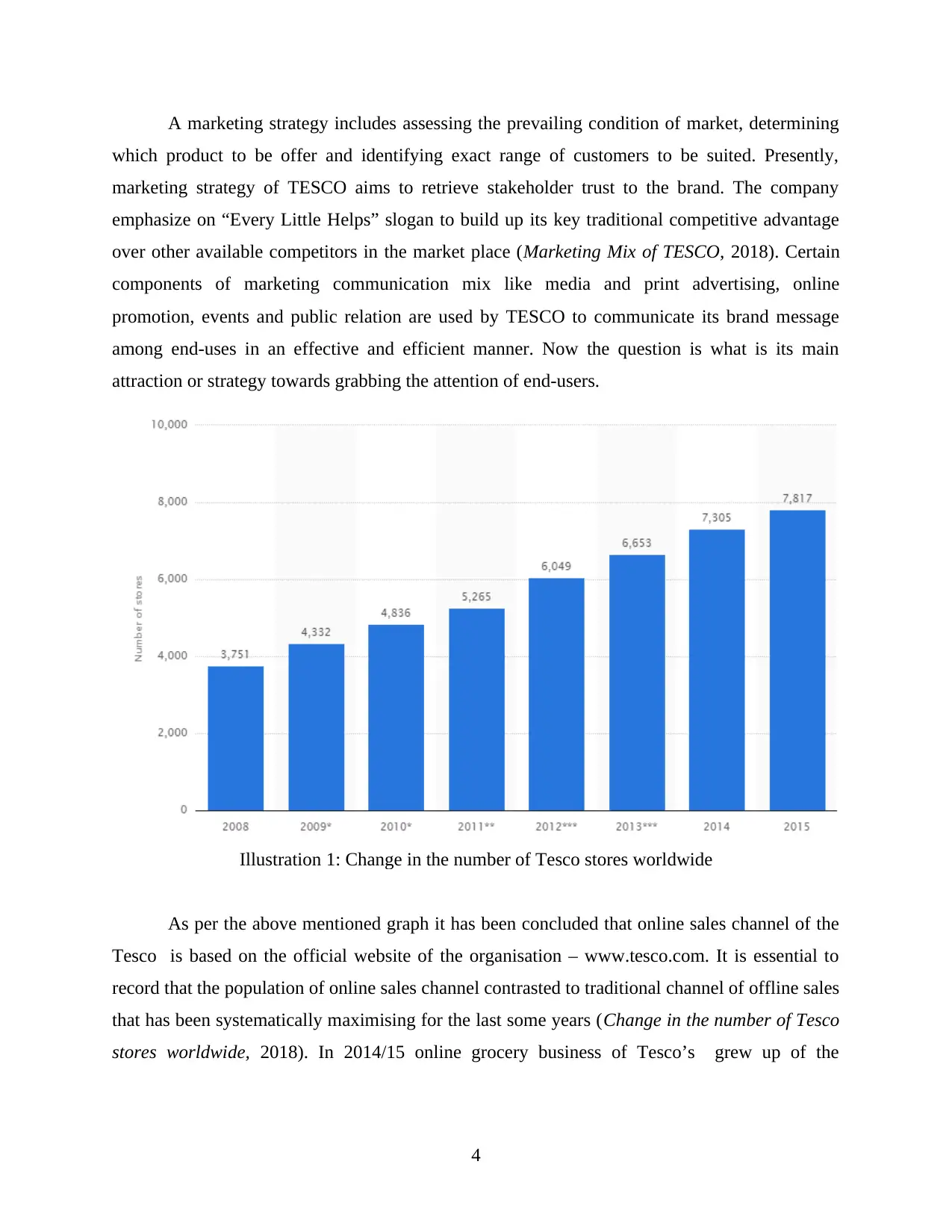
A marketing strategy includes assessing the prevailing condition of market, determining
which product to be offer and identifying exact range of customers to be suited. Presently,
marketing strategy of TESCO aims to retrieve stakeholder trust to the brand. The company
emphasize on “Every Little Helps” slogan to build up its key traditional competitive advantage
over other available competitors in the market place (Marketing Mix of TESCO, 2018). Certain
components of marketing communication mix like media and print advertising, online
promotion, events and public relation are used by TESCO to communicate its brand message
among end-uses in an effective and efficient manner. Now the question is what is its main
attraction or strategy towards grabbing the attention of end-users.
As per the above mentioned graph it has been concluded that online sales channel of the
Tesco is based on the official website of the organisation – www.tesco.com. It is essential to
record that the population of online sales channel contrasted to traditional channel of offline sales
that has been systematically maximising for the last some years (Change in the number of Tesco
stores worldwide, 2018). In 2014/15 online grocery business of Tesco’s grew up of the
4
Illustration 1: Change in the number of Tesco stores worldwide
which product to be offer and identifying exact range of customers to be suited. Presently,
marketing strategy of TESCO aims to retrieve stakeholder trust to the brand. The company
emphasize on “Every Little Helps” slogan to build up its key traditional competitive advantage
over other available competitors in the market place (Marketing Mix of TESCO, 2018). Certain
components of marketing communication mix like media and print advertising, online
promotion, events and public relation are used by TESCO to communicate its brand message
among end-uses in an effective and efficient manner. Now the question is what is its main
attraction or strategy towards grabbing the attention of end-users.
As per the above mentioned graph it has been concluded that online sales channel of the
Tesco is based on the official website of the organisation – www.tesco.com. It is essential to
record that the population of online sales channel contrasted to traditional channel of offline sales
that has been systematically maximising for the last some years (Change in the number of Tesco
stores worldwide, 2018). In 2014/15 online grocery business of Tesco’s grew up of the
4
Illustration 1: Change in the number of Tesco stores worldwide
Paraphrase This Document
Need a fresh take? Get an instant paraphrase of this document with our AI Paraphraser
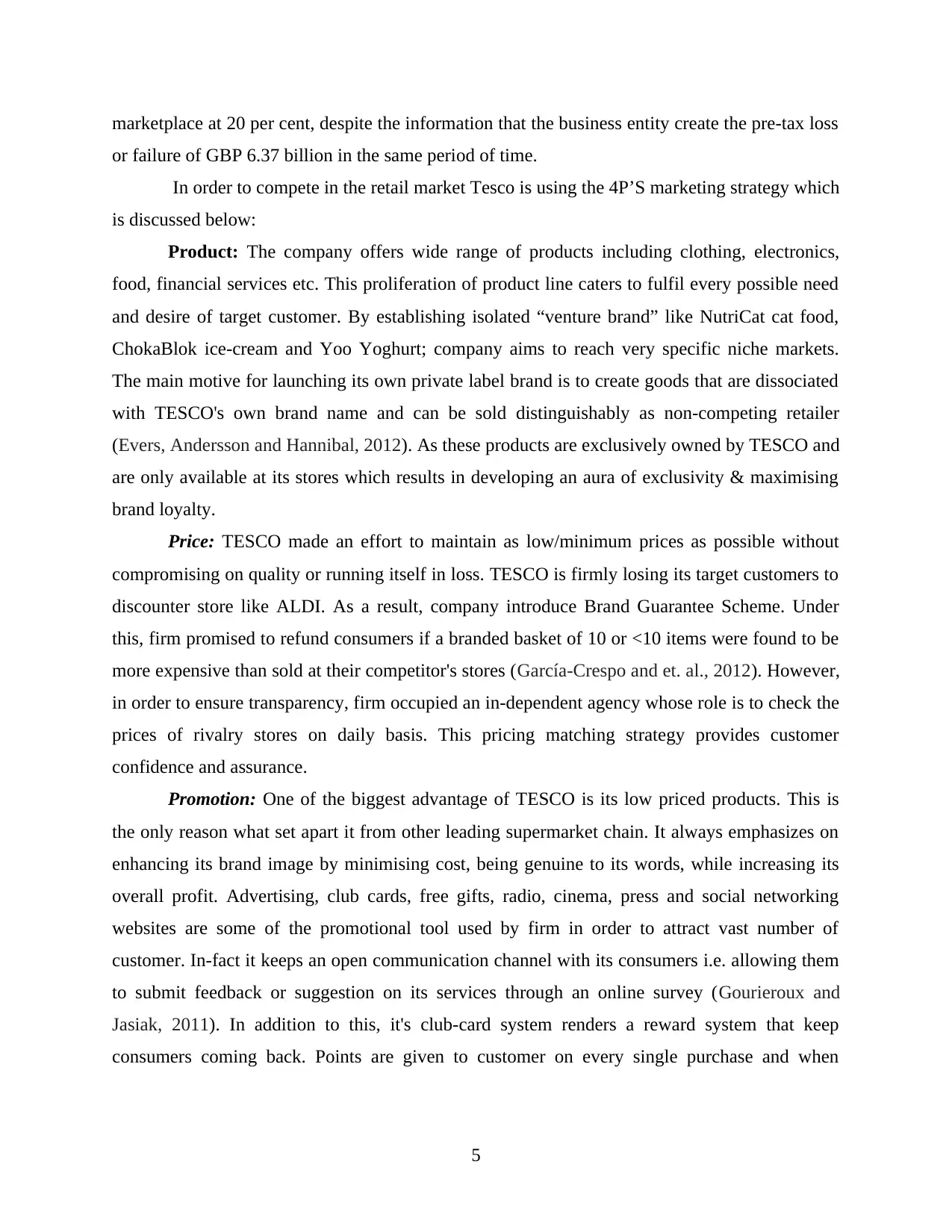
marketplace at 20 per cent, despite the information that the business entity create the pre-tax loss
or failure of GBP 6.37 billion in the same period of time.
In order to compete in the retail market Tesco is using the 4P’S marketing strategy which
is discussed below:
Product: The company offers wide range of products including clothing, electronics,
food, financial services etc. This proliferation of product line caters to fulfil every possible need
and desire of target customer. By establishing isolated “venture brand” like NutriCat cat food,
ChokaBlok ice-cream and Yoo Yoghurt; company aims to reach very specific niche markets.
The main motive for launching its own private label brand is to create goods that are dissociated
with TESCO's own brand name and can be sold distinguishably as non-competing retailer
(Evers, Andersson and Hannibal, 2012). As these products are exclusively owned by TESCO and
are only available at its stores which results in developing an aura of exclusivity & maximising
brand loyalty.
Price: TESCO made an effort to maintain as low/minimum prices as possible without
compromising on quality or running itself in loss. TESCO is firmly losing its target customers to
discounter store like ALDI. As a result, company introduce Brand Guarantee Scheme. Under
this, firm promised to refund consumers if a branded basket of 10 or <10 items were found to be
more expensive than sold at their competitor's stores (García-Crespo and et. al., 2012). However,
in order to ensure transparency, firm occupied an in-dependent agency whose role is to check the
prices of rivalry stores on daily basis. This pricing matching strategy provides customer
confidence and assurance.
Promotion: One of the biggest advantage of TESCO is its low priced products. This is
the only reason what set apart it from other leading supermarket chain. It always emphasizes on
enhancing its brand image by minimising cost, being genuine to its words, while increasing its
overall profit. Advertising, club cards, free gifts, radio, cinema, press and social networking
websites are some of the promotional tool used by firm in order to attract vast number of
customer. In-fact it keeps an open communication channel with its consumers i.e. allowing them
to submit feedback or suggestion on its services through an online survey (Gourieroux and
Jasiak, 2011). In addition to this, it's club-card system renders a reward system that keep
consumers coming back. Points are given to customer on every single purchase and when
5
or failure of GBP 6.37 billion in the same period of time.
In order to compete in the retail market Tesco is using the 4P’S marketing strategy which
is discussed below:
Product: The company offers wide range of products including clothing, electronics,
food, financial services etc. This proliferation of product line caters to fulfil every possible need
and desire of target customer. By establishing isolated “venture brand” like NutriCat cat food,
ChokaBlok ice-cream and Yoo Yoghurt; company aims to reach very specific niche markets.
The main motive for launching its own private label brand is to create goods that are dissociated
with TESCO's own brand name and can be sold distinguishably as non-competing retailer
(Evers, Andersson and Hannibal, 2012). As these products are exclusively owned by TESCO and
are only available at its stores which results in developing an aura of exclusivity & maximising
brand loyalty.
Price: TESCO made an effort to maintain as low/minimum prices as possible without
compromising on quality or running itself in loss. TESCO is firmly losing its target customers to
discounter store like ALDI. As a result, company introduce Brand Guarantee Scheme. Under
this, firm promised to refund consumers if a branded basket of 10 or <10 items were found to be
more expensive than sold at their competitor's stores (García-Crespo and et. al., 2012). However,
in order to ensure transparency, firm occupied an in-dependent agency whose role is to check the
prices of rivalry stores on daily basis. This pricing matching strategy provides customer
confidence and assurance.
Promotion: One of the biggest advantage of TESCO is its low priced products. This is
the only reason what set apart it from other leading supermarket chain. It always emphasizes on
enhancing its brand image by minimising cost, being genuine to its words, while increasing its
overall profit. Advertising, club cards, free gifts, radio, cinema, press and social networking
websites are some of the promotional tool used by firm in order to attract vast number of
customer. In-fact it keeps an open communication channel with its consumers i.e. allowing them
to submit feedback or suggestion on its services through an online survey (Gourieroux and
Jasiak, 2011). In addition to this, it's club-card system renders a reward system that keep
consumers coming back. Points are given to customer on every single purchase and when
5
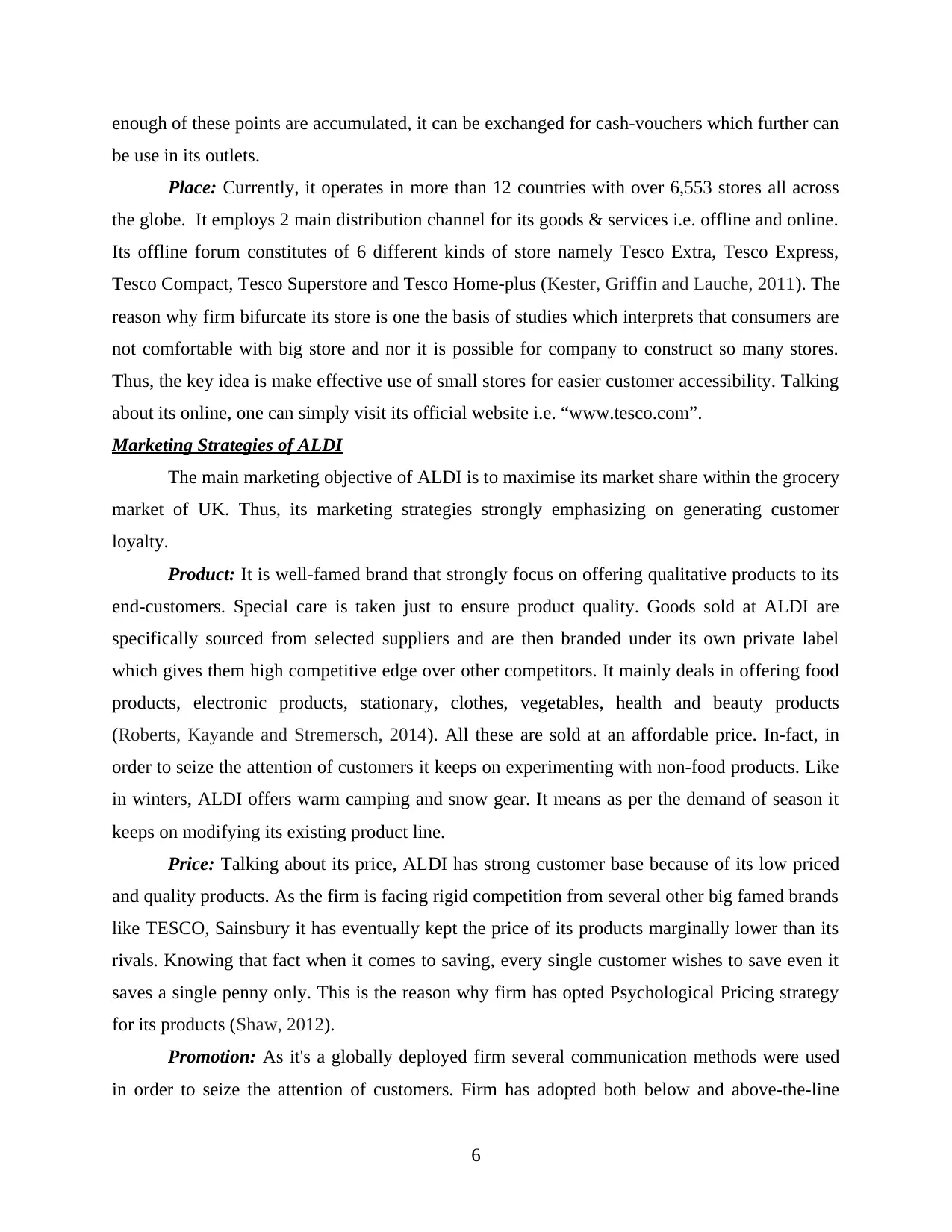
enough of these points are accumulated, it can be exchanged for cash-vouchers which further can
be use in its outlets.
Place: Currently, it operates in more than 12 countries with over 6,553 stores all across
the globe. It employs 2 main distribution channel for its goods & services i.e. offline and online.
Its offline forum constitutes of 6 different kinds of store namely Tesco Extra, Tesco Express,
Tesco Compact, Tesco Superstore and Tesco Home-plus (Kester, Griffin and Lauche, 2011). The
reason why firm bifurcate its store is one the basis of studies which interprets that consumers are
not comfortable with big store and nor it is possible for company to construct so many stores.
Thus, the key idea is make effective use of small stores for easier customer accessibility. Talking
about its online, one can simply visit its official website i.e. “www.tesco.com”.
Marketing Strategies of ALDI
The main marketing objective of ALDI is to maximise its market share within the grocery
market of UK. Thus, its marketing strategies strongly emphasizing on generating customer
loyalty.
Product: It is well-famed brand that strongly focus on offering qualitative products to its
end-customers. Special care is taken just to ensure product quality. Goods sold at ALDI are
specifically sourced from selected suppliers and are then branded under its own private label
which gives them high competitive edge over other competitors. It mainly deals in offering food
products, electronic products, stationary, clothes, vegetables, health and beauty products
(Roberts, Kayande and Stremersch, 2014). All these are sold at an affordable price. In-fact, in
order to seize the attention of customers it keeps on experimenting with non-food products. Like
in winters, ALDI offers warm camping and snow gear. It means as per the demand of season it
keeps on modifying its existing product line.
Price: Talking about its price, ALDI has strong customer base because of its low priced
and quality products. As the firm is facing rigid competition from several other big famed brands
like TESCO, Sainsbury it has eventually kept the price of its products marginally lower than its
rivals. Knowing that fact when it comes to saving, every single customer wishes to save even it
saves a single penny only. This is the reason why firm has opted Psychological Pricing strategy
for its products (Shaw, 2012).
Promotion: As it's a globally deployed firm several communication methods were used
in order to seize the attention of customers. Firm has adopted both below and above-the-line
6
be use in its outlets.
Place: Currently, it operates in more than 12 countries with over 6,553 stores all across
the globe. It employs 2 main distribution channel for its goods & services i.e. offline and online.
Its offline forum constitutes of 6 different kinds of store namely Tesco Extra, Tesco Express,
Tesco Compact, Tesco Superstore and Tesco Home-plus (Kester, Griffin and Lauche, 2011). The
reason why firm bifurcate its store is one the basis of studies which interprets that consumers are
not comfortable with big store and nor it is possible for company to construct so many stores.
Thus, the key idea is make effective use of small stores for easier customer accessibility. Talking
about its online, one can simply visit its official website i.e. “www.tesco.com”.
Marketing Strategies of ALDI
The main marketing objective of ALDI is to maximise its market share within the grocery
market of UK. Thus, its marketing strategies strongly emphasizing on generating customer
loyalty.
Product: It is well-famed brand that strongly focus on offering qualitative products to its
end-customers. Special care is taken just to ensure product quality. Goods sold at ALDI are
specifically sourced from selected suppliers and are then branded under its own private label
which gives them high competitive edge over other competitors. It mainly deals in offering food
products, electronic products, stationary, clothes, vegetables, health and beauty products
(Roberts, Kayande and Stremersch, 2014). All these are sold at an affordable price. In-fact, in
order to seize the attention of customers it keeps on experimenting with non-food products. Like
in winters, ALDI offers warm camping and snow gear. It means as per the demand of season it
keeps on modifying its existing product line.
Price: Talking about its price, ALDI has strong customer base because of its low priced
and quality products. As the firm is facing rigid competition from several other big famed brands
like TESCO, Sainsbury it has eventually kept the price of its products marginally lower than its
rivals. Knowing that fact when it comes to saving, every single customer wishes to save even it
saves a single penny only. This is the reason why firm has opted Psychological Pricing strategy
for its products (Shaw, 2012).
Promotion: As it's a globally deployed firm several communication methods were used
in order to seize the attention of customers. Firm has adopted both below and above-the-line
6
⊘ This is a preview!⊘
Do you want full access?
Subscribe today to unlock all pages.

Trusted by 1+ million students worldwide
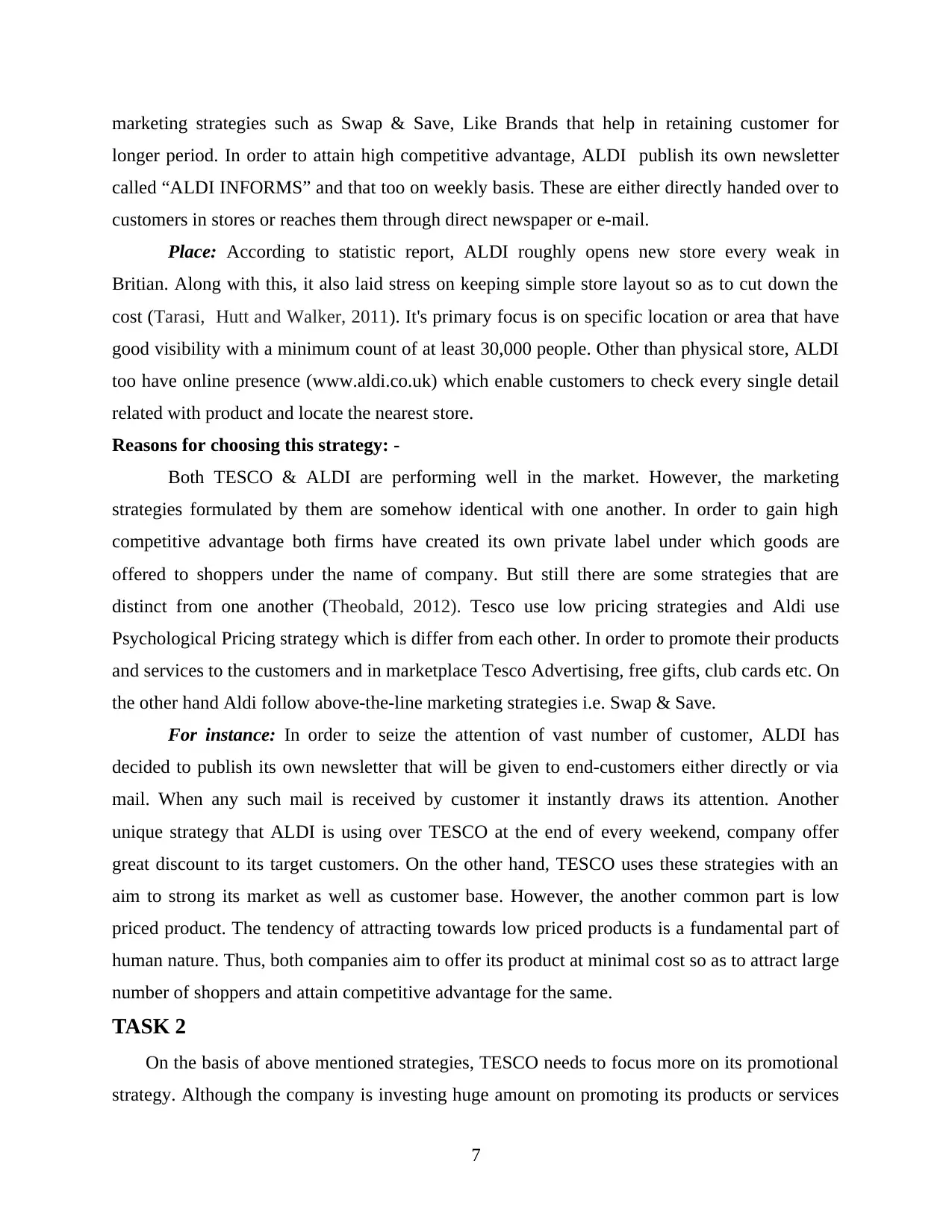
marketing strategies such as Swap & Save, Like Brands that help in retaining customer for
longer period. In order to attain high competitive advantage, ALDI publish its own newsletter
called “ALDI INFORMS” and that too on weekly basis. These are either directly handed over to
customers in stores or reaches them through direct newspaper or e-mail.
Place: According to statistic report, ALDI roughly opens new store every weak in
Britian. Along with this, it also laid stress on keeping simple store layout so as to cut down the
cost (Tarasi, Hutt and Walker, 2011). It's primary focus is on specific location or area that have
good visibility with a minimum count of at least 30,000 people. Other than physical store, ALDI
too have online presence (www.aldi.co.uk) which enable customers to check every single detail
related with product and locate the nearest store.
Reasons for choosing this strategy: -
Both TESCO & ALDI are performing well in the market. However, the marketing
strategies formulated by them are somehow identical with one another. In order to gain high
competitive advantage both firms have created its own private label under which goods are
offered to shoppers under the name of company. But still there are some strategies that are
distinct from one another (Theobald, 2012). Tesco use low pricing strategies and Aldi use
Psychological Pricing strategy which is differ from each other. In order to promote their products
and services to the customers and in marketplace Tesco Advertising, free gifts, club cards etc. On
the other hand Aldi follow above-the-line marketing strategies i.e. Swap & Save.
For instance: In order to seize the attention of vast number of customer, ALDI has
decided to publish its own newsletter that will be given to end-customers either directly or via
mail. When any such mail is received by customer it instantly draws its attention. Another
unique strategy that ALDI is using over TESCO at the end of every weekend, company offer
great discount to its target customers. On the other hand, TESCO uses these strategies with an
aim to strong its market as well as customer base. However, the another common part is low
priced product. The tendency of attracting towards low priced products is a fundamental part of
human nature. Thus, both companies aim to offer its product at minimal cost so as to attract large
number of shoppers and attain competitive advantage for the same.
TASK 2
On the basis of above mentioned strategies, TESCO needs to focus more on its promotional
strategy. Although the company is investing huge amount on promoting its products or services
7
longer period. In order to attain high competitive advantage, ALDI publish its own newsletter
called “ALDI INFORMS” and that too on weekly basis. These are either directly handed over to
customers in stores or reaches them through direct newspaper or e-mail.
Place: According to statistic report, ALDI roughly opens new store every weak in
Britian. Along with this, it also laid stress on keeping simple store layout so as to cut down the
cost (Tarasi, Hutt and Walker, 2011). It's primary focus is on specific location or area that have
good visibility with a minimum count of at least 30,000 people. Other than physical store, ALDI
too have online presence (www.aldi.co.uk) which enable customers to check every single detail
related with product and locate the nearest store.
Reasons for choosing this strategy: -
Both TESCO & ALDI are performing well in the market. However, the marketing
strategies formulated by them are somehow identical with one another. In order to gain high
competitive advantage both firms have created its own private label under which goods are
offered to shoppers under the name of company. But still there are some strategies that are
distinct from one another (Theobald, 2012). Tesco use low pricing strategies and Aldi use
Psychological Pricing strategy which is differ from each other. In order to promote their products
and services to the customers and in marketplace Tesco Advertising, free gifts, club cards etc. On
the other hand Aldi follow above-the-line marketing strategies i.e. Swap & Save.
For instance: In order to seize the attention of vast number of customer, ALDI has
decided to publish its own newsletter that will be given to end-customers either directly or via
mail. When any such mail is received by customer it instantly draws its attention. Another
unique strategy that ALDI is using over TESCO at the end of every weekend, company offer
great discount to its target customers. On the other hand, TESCO uses these strategies with an
aim to strong its market as well as customer base. However, the another common part is low
priced product. The tendency of attracting towards low priced products is a fundamental part of
human nature. Thus, both companies aim to offer its product at minimal cost so as to attract large
number of shoppers and attain competitive advantage for the same.
TASK 2
On the basis of above mentioned strategies, TESCO needs to focus more on its promotional
strategy. Although the company is investing huge amount on promoting its products or services
7
Paraphrase This Document
Need a fresh take? Get an instant paraphrase of this document with our AI Paraphraser
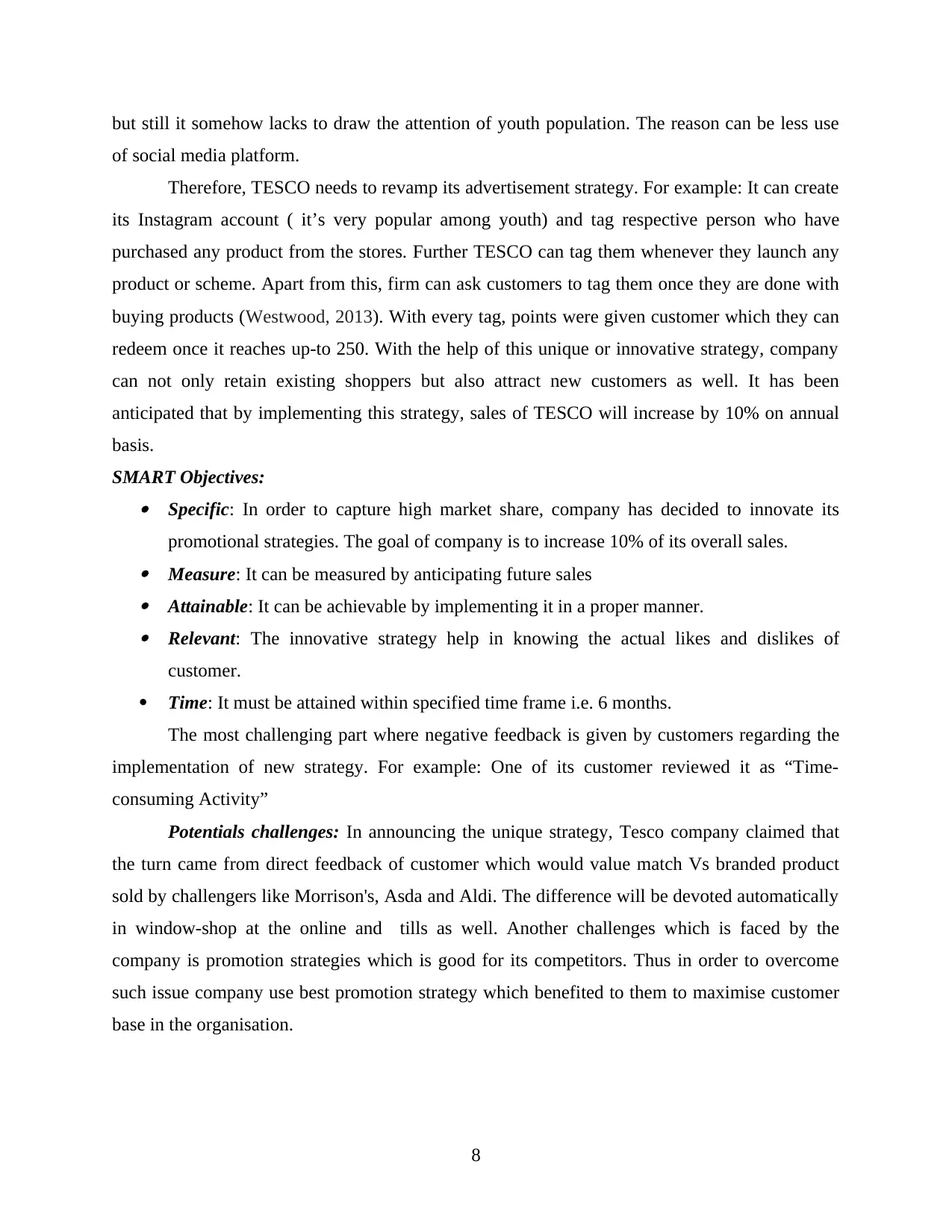
but still it somehow lacks to draw the attention of youth population. The reason can be less use
of social media platform.
Therefore, TESCO needs to revamp its advertisement strategy. For example: It can create
its Instagram account ( it’s very popular among youth) and tag respective person who have
purchased any product from the stores. Further TESCO can tag them whenever they launch any
product or scheme. Apart from this, firm can ask customers to tag them once they are done with
buying products (Westwood, 2013). With every tag, points were given customer which they can
redeem once it reaches up-to 250. With the help of this unique or innovative strategy, company
can not only retain existing shoppers but also attract new customers as well. It has been
anticipated that by implementing this strategy, sales of TESCO will increase by 10% on annual
basis.
SMART Objectives: Specific: In order to capture high market share, company has decided to innovate its
promotional strategies. The goal of company is to increase 10% of its overall sales. Measure: It can be measured by anticipating future sales Attainable: It can be achievable by implementing it in a proper manner. Relevant: The innovative strategy help in knowing the actual likes and dislikes of
customer.
Time: It must be attained within specified time frame i.e. 6 months.
The most challenging part where negative feedback is given by customers regarding the
implementation of new strategy. For example: One of its customer reviewed it as “Time-
consuming Activity”
Potentials challenges: In announcing the unique strategy, Tesco company claimed that
the turn came from direct feedback of customer which would value match Vs branded product
sold by challengers like Morrison's, Asda and Aldi. The difference will be devoted automatically
in window-shop at the online and tills as well. Another challenges which is faced by the
company is promotion strategies which is good for its competitors. Thus in order to overcome
such issue company use best promotion strategy which benefited to them to maximise customer
base in the organisation.
8
of social media platform.
Therefore, TESCO needs to revamp its advertisement strategy. For example: It can create
its Instagram account ( it’s very popular among youth) and tag respective person who have
purchased any product from the stores. Further TESCO can tag them whenever they launch any
product or scheme. Apart from this, firm can ask customers to tag them once they are done with
buying products (Westwood, 2013). With every tag, points were given customer which they can
redeem once it reaches up-to 250. With the help of this unique or innovative strategy, company
can not only retain existing shoppers but also attract new customers as well. It has been
anticipated that by implementing this strategy, sales of TESCO will increase by 10% on annual
basis.
SMART Objectives: Specific: In order to capture high market share, company has decided to innovate its
promotional strategies. The goal of company is to increase 10% of its overall sales. Measure: It can be measured by anticipating future sales Attainable: It can be achievable by implementing it in a proper manner. Relevant: The innovative strategy help in knowing the actual likes and dislikes of
customer.
Time: It must be attained within specified time frame i.e. 6 months.
The most challenging part where negative feedback is given by customers regarding the
implementation of new strategy. For example: One of its customer reviewed it as “Time-
consuming Activity”
Potentials challenges: In announcing the unique strategy, Tesco company claimed that
the turn came from direct feedback of customer which would value match Vs branded product
sold by challengers like Morrison's, Asda and Aldi. The difference will be devoted automatically
in window-shop at the online and tills as well. Another challenges which is faced by the
company is promotion strategies which is good for its competitors. Thus in order to overcome
such issue company use best promotion strategy which benefited to them to maximise customer
base in the organisation.
8
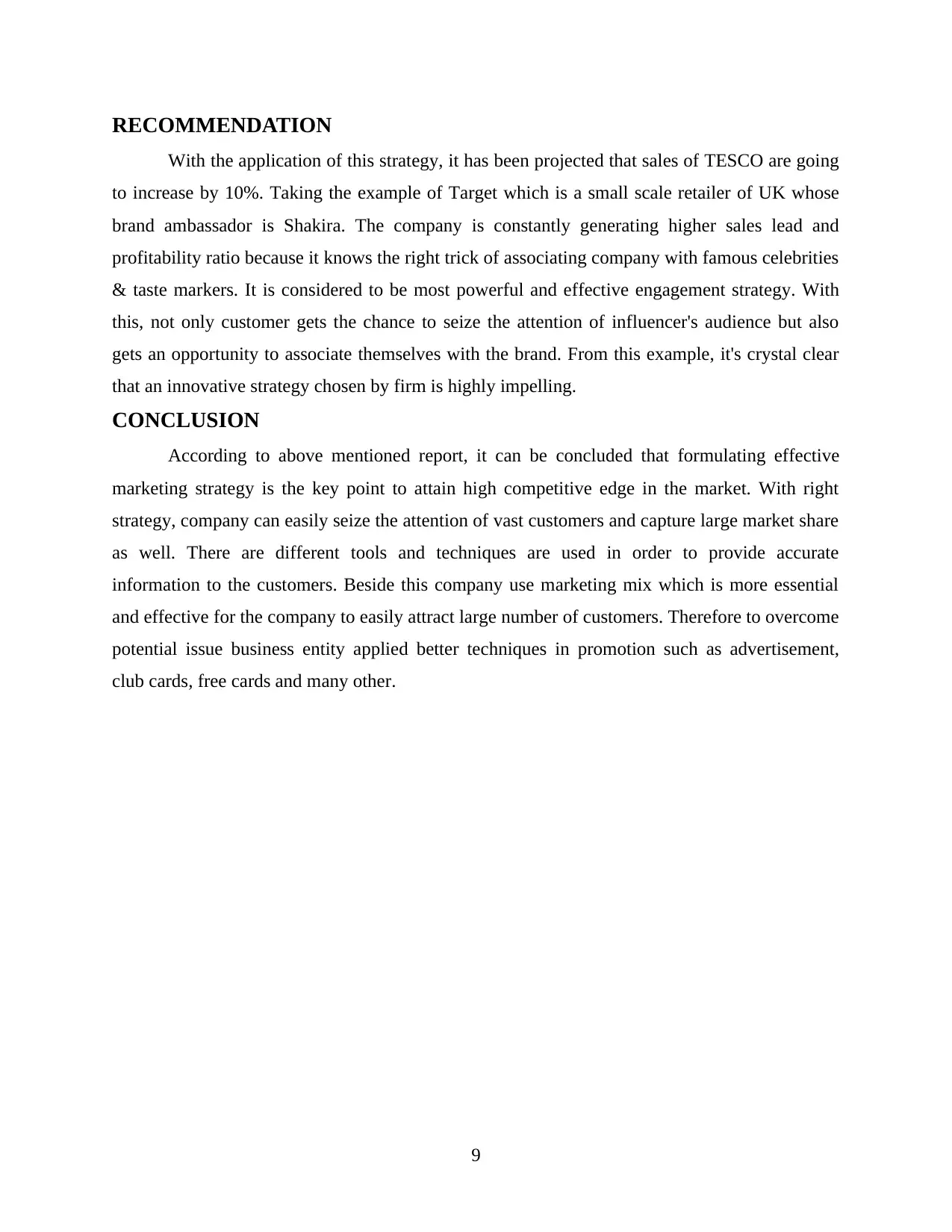
RECOMMENDATION
With the application of this strategy, it has been projected that sales of TESCO are going
to increase by 10%. Taking the example of Target which is a small scale retailer of UK whose
brand ambassador is Shakira. The company is constantly generating higher sales lead and
profitability ratio because it knows the right trick of associating company with famous celebrities
& taste markers. It is considered to be most powerful and effective engagement strategy. With
this, not only customer gets the chance to seize the attention of influencer's audience but also
gets an opportunity to associate themselves with the brand. From this example, it's crystal clear
that an innovative strategy chosen by firm is highly impelling.
CONCLUSION
According to above mentioned report, it can be concluded that formulating effective
marketing strategy is the key point to attain high competitive edge in the market. With right
strategy, company can easily seize the attention of vast customers and capture large market share
as well. There are different tools and techniques are used in order to provide accurate
information to the customers. Beside this company use marketing mix which is more essential
and effective for the company to easily attract large number of customers. Therefore to overcome
potential issue business entity applied better techniques in promotion such as advertisement,
club cards, free cards and many other.
9
With the application of this strategy, it has been projected that sales of TESCO are going
to increase by 10%. Taking the example of Target which is a small scale retailer of UK whose
brand ambassador is Shakira. The company is constantly generating higher sales lead and
profitability ratio because it knows the right trick of associating company with famous celebrities
& taste markers. It is considered to be most powerful and effective engagement strategy. With
this, not only customer gets the chance to seize the attention of influencer's audience but also
gets an opportunity to associate themselves with the brand. From this example, it's crystal clear
that an innovative strategy chosen by firm is highly impelling.
CONCLUSION
According to above mentioned report, it can be concluded that formulating effective
marketing strategy is the key point to attain high competitive edge in the market. With right
strategy, company can easily seize the attention of vast customers and capture large market share
as well. There are different tools and techniques are used in order to provide accurate
information to the customers. Beside this company use marketing mix which is more essential
and effective for the company to easily attract large number of customers. Therefore to overcome
potential issue business entity applied better techniques in promotion such as advertisement,
club cards, free cards and many other.
9
⊘ This is a preview!⊘
Do you want full access?
Subscribe today to unlock all pages.

Trusted by 1+ million students worldwide
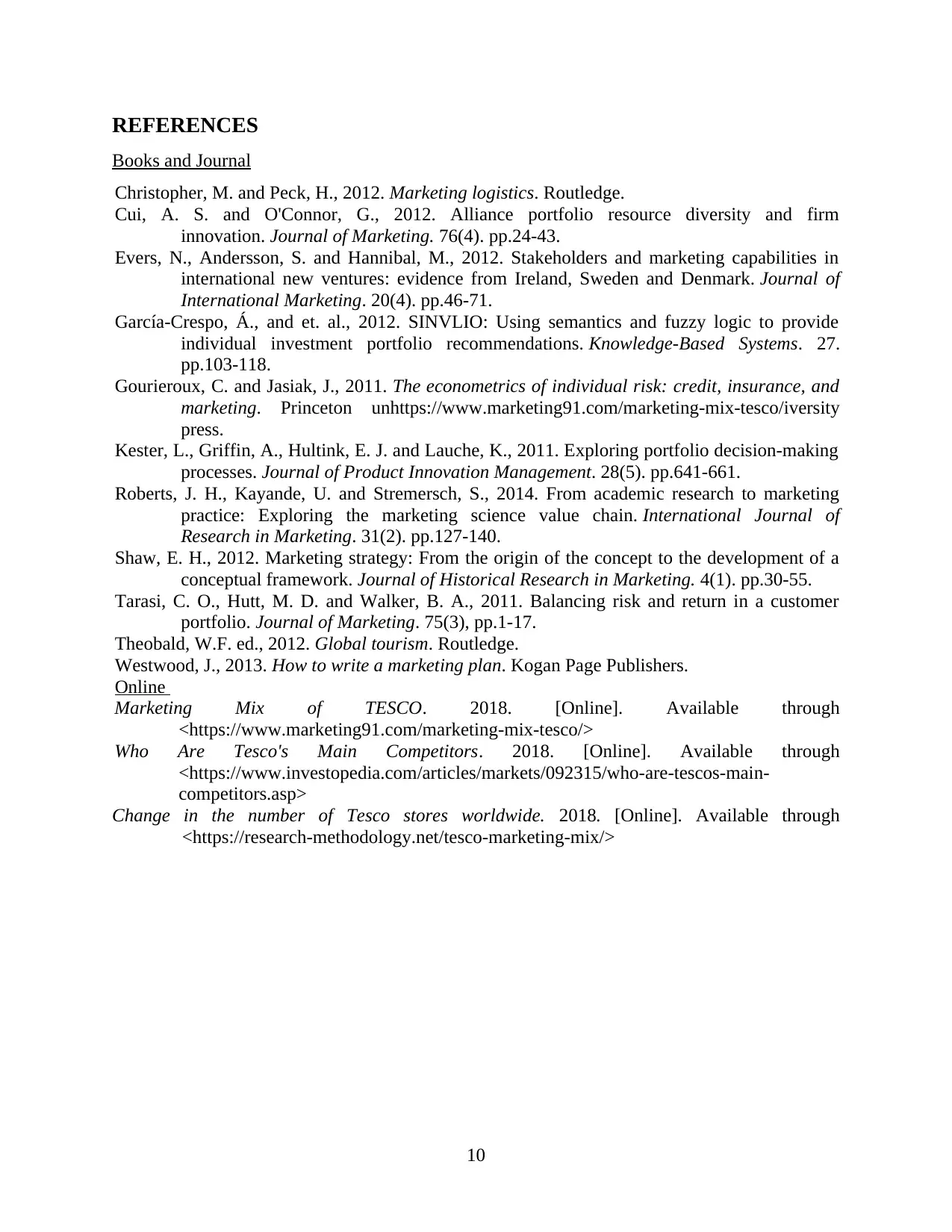
REFERENCES
Books and Journal
Christopher, M. and Peck, H., 2012. Marketing logistics. Routledge.
Cui, A. S. and O'Connor, G., 2012. Alliance portfolio resource diversity and firm
innovation. Journal of Marketing. 76(4). pp.24-43.
Evers, N., Andersson, S. and Hannibal, M., 2012. Stakeholders and marketing capabilities in
international new ventures: evidence from Ireland, Sweden and Denmark. Journal of
International Marketing. 20(4). pp.46-71.
García-Crespo, Á., and et. al., 2012. SINVLIO: Using semantics and fuzzy logic to provide
individual investment portfolio recommendations. Knowledge-Based Systems. 27.
pp.103-118.
Gourieroux, C. and Jasiak, J., 2011. The econometrics of individual risk: credit, insurance, and
marketing. Princeton unhttps://www.marketing91.com/marketing-mix-tesco/iversity
press.
Kester, L., Griffin, A., Hultink, E. J. and Lauche, K., 2011. Exploring portfolio decision‐making
processes. Journal of Product Innovation Management. 28(5). pp.641-661.
Roberts, J. H., Kayande, U. and Stremersch, S., 2014. From academic research to marketing
practice: Exploring the marketing science value chain. International Journal of
Research in Marketing. 31(2). pp.127-140.
Shaw, E. H., 2012. Marketing strategy: From the origin of the concept to the development of a
conceptual framework. Journal of Historical Research in Marketing. 4(1). pp.30-55.
Tarasi, C. O., Hutt, M. D. and Walker, B. A., 2011. Balancing risk and return in a customer
portfolio. Journal of Marketing. 75(3), pp.1-17.
Theobald, W.F. ed., 2012. Global tourism. Routledge.
Westwood, J., 2013. How to write a marketing plan. Kogan Page Publishers.
Online
Marketing Mix of TESCO. 2018. [Online]. Available through
<https://www.marketing91.com/marketing-mix-tesco/>
Who Are Tesco's Main Competitors. 2018. [Online]. Available through
<https://www.investopedia.com/articles/markets/092315/who-are-tescos-main-
competitors.asp>
Change in the number of Tesco stores worldwide. 2018. [Online]. Available through
<https://research-methodology.net/tesco-marketing-mix/>
10
Books and Journal
Christopher, M. and Peck, H., 2012. Marketing logistics. Routledge.
Cui, A. S. and O'Connor, G., 2012. Alliance portfolio resource diversity and firm
innovation. Journal of Marketing. 76(4). pp.24-43.
Evers, N., Andersson, S. and Hannibal, M., 2012. Stakeholders and marketing capabilities in
international new ventures: evidence from Ireland, Sweden and Denmark. Journal of
International Marketing. 20(4). pp.46-71.
García-Crespo, Á., and et. al., 2012. SINVLIO: Using semantics and fuzzy logic to provide
individual investment portfolio recommendations. Knowledge-Based Systems. 27.
pp.103-118.
Gourieroux, C. and Jasiak, J., 2011. The econometrics of individual risk: credit, insurance, and
marketing. Princeton unhttps://www.marketing91.com/marketing-mix-tesco/iversity
press.
Kester, L., Griffin, A., Hultink, E. J. and Lauche, K., 2011. Exploring portfolio decision‐making
processes. Journal of Product Innovation Management. 28(5). pp.641-661.
Roberts, J. H., Kayande, U. and Stremersch, S., 2014. From academic research to marketing
practice: Exploring the marketing science value chain. International Journal of
Research in Marketing. 31(2). pp.127-140.
Shaw, E. H., 2012. Marketing strategy: From the origin of the concept to the development of a
conceptual framework. Journal of Historical Research in Marketing. 4(1). pp.30-55.
Tarasi, C. O., Hutt, M. D. and Walker, B. A., 2011. Balancing risk and return in a customer
portfolio. Journal of Marketing. 75(3), pp.1-17.
Theobald, W.F. ed., 2012. Global tourism. Routledge.
Westwood, J., 2013. How to write a marketing plan. Kogan Page Publishers.
Online
Marketing Mix of TESCO. 2018. [Online]. Available through
<https://www.marketing91.com/marketing-mix-tesco/>
Who Are Tesco's Main Competitors. 2018. [Online]. Available through
<https://www.investopedia.com/articles/markets/092315/who-are-tescos-main-
competitors.asp>
Change in the number of Tesco stores worldwide. 2018. [Online]. Available through
<https://research-methodology.net/tesco-marketing-mix/>
10
1 out of 10
Related Documents
Your All-in-One AI-Powered Toolkit for Academic Success.
+13062052269
info@desklib.com
Available 24*7 on WhatsApp / Email
![[object Object]](/_next/static/media/star-bottom.7253800d.svg)
Unlock your academic potential
Copyright © 2020–2025 A2Z Services. All Rights Reserved. Developed and managed by ZUCOL.





